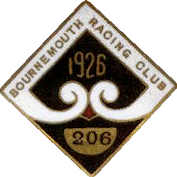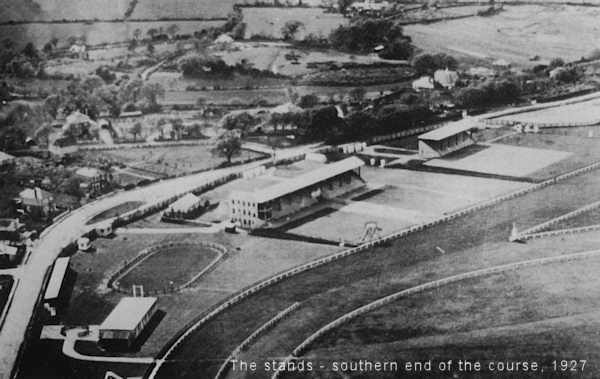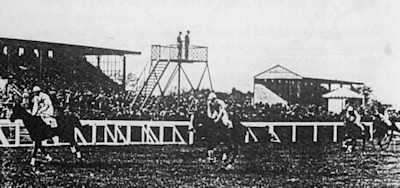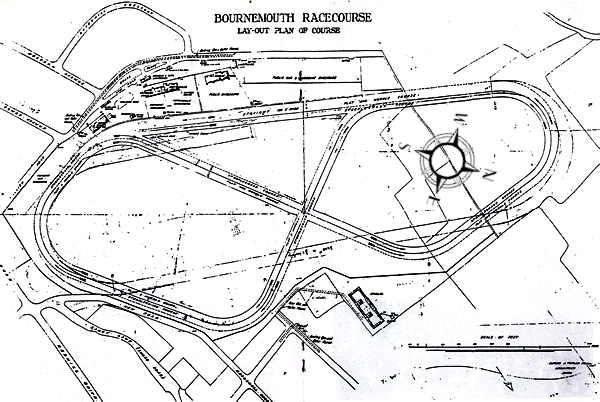|
Days at the Races
When RAF Winton reverted
to civilian use in 1919, the owners looked at new ways of maximising
income from the Ensbury Park site.
 Aviation
was not yet a fully economic proposition and they came up with
a new idea - to bring horse racing to the area. The dream was
to create the new Ascot of the South coast - and they very nearly
did it! Aviation
was not yet a fully economic proposition and they came up with
a new idea - to bring horse racing to the area. The dream was
to create the new Ascot of the South coast - and they very nearly
did it!
Moves to set up a racecourse began in 1921 and by
1924 Sir Robert McAlpine's civil engineering firm had been awarded
a contract to construct a course including two grandstands (one
of which could accommodate 3000 people), administrative buildings,
stables for 100 horses and also car parks.
The choice of McAlpine showed that the project was
serious. The company had just finished constructing Britain's
most prestigious modern building - the Wembley Stadium!
Several hundred men were employed to maintain the
course and the first meeting set for April 1925. The National
Hunt allocated two further three day meetings in November and
December.
A run for their money
The track was a two mile figure of eight with a
steeple chasing course on the outside, a hurdles course on the
inside and a four furlong straight.
 There
were eleven gorse and bush fences, eight plain fences, two open
ditches and a water jump. There
were eleven gorse and bush fences, eight plain fences, two open
ditches and a water jump.
The angles of the beds was set so that horses could
take the corners at full gallop.
At least one journalist at the time described it
as promising to be the best racecourse in the country. The directors
hoped to make it a fashionable and sophisticated venue, but they
were not without opposition. Some influential members of Bournemouth
council voiced the opinion that horse racing was vulgar and morally
decadent.
Invasion of punters
Enthusiasts drove to Bournemouth from all over the
country, and Southern Railways laid on special trains for the
inaugural Easter meeting on April 17, 1925.
Punters travelled by tram from the Central Station
to the terminus in Moordown and were then transported to the course
by a fleet of privately run charabancs The tram fare was only
3 pence, but there were complaints about the charabanc operators
who were charging eight times as much for their part of the journey
- not much less than the bus fare to Southampton!

Racegoers were greeted with a festive atmosphere
and a military band. But the racing itself did not live up to
expectations - a lot of horses dropped out for one reason or another.
The first day proved to be a fashionable occasion
with members of the aristocracy arriving from far and wide. The
papers went wild with praise, but the bookies grumbled. Despite
a crowd of twelve thousand, nobody much had been betting!
 Original
plans were reigned back and there were just two more one day meetings
that year, followed by three two day meetings in 1927 and two
in 1928. Original
plans were reigned back and there were just two more one day meetings
that year, followed by three two day meetings in 1927 and two
in 1928.
At the last meeting in April 1928, one of the jockeys
was Lester Piggot's father Keith.
Flying races had started at the racecourse in April
1926, and greyhound racing began at the course in January 1928
- only a year or so after it was first introduced to Britain.
The meetings were greeted by enthusiastic crowds,
but opposed by local religious leaders who were against gambling.
Fate strikes a blow
But greyhound racing was short lived. In a shock
announcement, the National Hunt declared that the dog racing had
to stop or they would withdraw permission for horse racing. After
nine meetings, the greyhounds were transferred to a track at Victoria
Park.
A few minor events were arranged to try and revive
the ailing course. In November 1927 the Bournemouth Gypsy Motor
club staged a grass track speedway meeting on the course. In May
1928 there was a pony racing meeting.
It was all too late. The Racecourse Company went
bust in June 1928, followed a short time later by the Greyhound
Racing company.
The land was sold up for housing and in 1931 the
first homes were built there on what was to be the Leybourne Estate.
The last trace of the race course was a grandstand
which was pulled down in in 1934. Parts of it are reportedly still
to be found in the fences and gardens of houses in the vicinity.

To put the location in current context, the northernmost
part of the figure eight is approximately where Leybourne Avenue
now meets Dudley Road. Leybourne Avenue runs down what was the
centre of the site. The course is bounded to the south and west
by Hillview Road.
Western Avenue is more or less built on the fast
straight part of the course. The paddock and stands were in what
are now the gardens of houses in Western Avenue and Hillview Road.
|